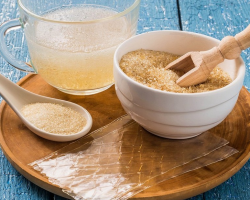From this article you will learn which seas on Earth are the most salty.
Content
The fact that the water of the sea is brackish - knows the majority, but how salty it is, we rarely think about it. And what is the most salty of the 80 seas on our planet? We find out in this article.
The most salty sea on earth is the Dead Sea

The most salty sea on the planet is the Dead Sea. It is 10 times more salty than the average ocean (34 g in the ocean by 340 g per 1 liter of water - in the Dead Sea). Such high salinity is explained by the fact that only one small Jordan river flows into it, not flowing nowhere, the climate is very hot, strong evaporation occurs, and the rains fall very rarely. Since the Dead Sea is in no way connected with the ocean, the opinions of scientists about it diverge: some consider it a sea, others - a lake.
The Dead Sea - This is a hollow, located below the level of the ocean by 423 m, with an area of \u200b\u200b650 km2, its largest depth of 380 m. The sea is unsightly at first glance - everything is covered with salt on the shore. It was formed due to the extension of two tectonic plates. The Dead Sea washes the shores of Jordan, Palestine and Israel.
The Dead Sea is not called dead in vain - no one lives here, except for some bacteria, even algae do not survive in such salt water. But to swim in such water and smear the mud that is on the coast is useful. The air of the Dead Sea is also useful - it is saturated with oxygen by 15% more than in other corners of the Earth, since the sea is below the ocean. It is impossible to drown in the Dead Sea - the water is so salty that it holds a person on his surface.
The second in salinity is the Red Sea

The Red Sea is the youngest sea of \u200b\u200ball the seas. It was formed as a result of the movement of glaciers, close to 25 million years ago. If you look from above, and in a reduced version, the Red Sea has the shape of a trough. It takes second place in salinity - 41 g in 1 liter of water, in some bays (Akabsky, Eilat) it reaches 60 g of salt per 1 liter.
The water of the Red Sea is always warm, even in winter below 21̊c does not fall, and this is due not only to heating from the sun, but also by the intake of warm sources from the bottom.
The animal world of the Red Sea is very diverse:
- Safe fish (Popugai fish, baskets, -For; PlataCs)
- Poisonous fish (fish surgeons, camnia; slopes, marine dragon)
- Dangerous fish (fish -fish, crookodils; tiger shark, barracuda, murena)
- Octopuses
- Sea turtles
On the coast of the Red Sea are Saudi Arabia, Yemen, Somalia, Eritrea, Sudan and Egypt. The sea area is 438 thousand km 2, the largest depth is 2.2 km.
Third in salinity - Mediterranean Sea

In the Mediterranean Sea, water from the ocean enters the Gibraltar Strait. The climate of the Mediterranean is subtropical: winter is warm, but sometimes storms, the summer is hot. The sea is rich in fish (tuna, flounder, mackerel), oysters, mussels and mollusks. Dolphins (Afalina, Belobochka) live in the Mediterranean Sea. There are dangerous inhabitants at sea:
- Sharks
- Fiery worms (if they touch the skin of a person, then strongly burn)
- Jellyfish (can also burn)
- Murans (a bite for a person can lead to death)
- Sea hedgehogs (a fragment of a needle remaining in the body can cause severe inflammation)
- Anemones in appearance as plants have paralyzing poison
- Robin fish is a type of fish-flue, has a poisonous gland, and only an experienced cook can prepare it correctly
- Cone - mollusk that has paralyzing poison, dangerous for humans
Saltness of water 39 g per 1 liter of water. The coast of the Mediterranean Sea has long been inhabited by European countries:
- Spain
- Italy
- France
- Slovenia
- Montenegro
- Bosnia and Herzegovina
- Albania
- Greece
Along with Asian countries:
- Israel
- Turkey
- Lebanon
- Syria
And the countries of Africa:
- Libya
- Tunisia
- Algeria
- Egypt
- Morocco
In the area of \u200b\u200bthe Mediterranean Sea, it occupies a huge territory - 2.5 million km 2, the deepest places in the sea reach 5.1 km.
the Aegean sea

In the Aegean Sea, water with a salinity of 38 g per 1 liter of water. About 2 thousand islands are concentrated in the sea. The shores of the sea are rocky, the bottom is sandy with a few algae. Warm water in summer, in winter below 11 degrees of heat Celsius, does not fall.
Previously, there were many fauna and flora in the Aegean Sea, now it has diminished due to the pollution of the sea. Now octopuses, lips, crabs, sea crucians, yellow -tailed perches live in the sea. Of the dangerous inhabitants of the sea, there are 35 species of sharks, but only 4 of them are dangerous for people.
Greece and Turkey are located on the shores of the Aegean Sea. Sea area 215 thousand km 2, the largest depth is 2.5 km.
The ionic sea

The salinity of water in the ionic sea is 38 g per 1 liter of water. In summer, water heats up to 27̊c, in winter below 14 degrees the heat of Celsius does not fall. On the shores of the sea and the islands (Corfu, Sicily, Pathra, Skating, Taranto), world -famous resorts are located in the sea. The beaches here are very different: rocky, from pebble and sandy. Sea animals found in the sea are diverse:
- Edible fish (mackerel, kefal, flounder, tuna)
- Octopuses
- Big turtles
- Sea hedgehogs (a lot, you can’t walk barefoot in the water)
- Dolphins
On the shores of the Ionian Sea, Italy, Greece and Albania were located. The sea is deep, occupies an area of \u200b\u200b169 thousand km 2, in some places the depth of the sea is up to 5.1 km.
Japanese Sea

The salinity of the Sea of \u200b\u200bJapan 35 g per 1 liter of water. Although the sea is not very warm, and the salinity in it is quite high, given the fact that water almost does not enter the Japanese Sea from the Pacific Ocean. In winter, the sea is covered with ice.
The water in the Sea of \u200b\u200bJapan is transparent, visibility in a depth of 10 m. The coasts of Russia, Japan, North and Southern Koreans are washed by the Japanese Sea. The sea is rich in diverse marine plants:
- Algae - 225 different types
And animals:
- Giant crabs with a grand scale of up to 1.5 m
- Giant and ordinary mollusks
- Sea stars
- Media
- About 200 types of edible fish
- Squids
- Tripanders
- Shrimp, up to 18 cm long
- Giant octopuses, up to 3 m long
- Dolphins
- Whales
- 12 species of sharks not dangerous for humans
- Seals
The Japanese Sea occupies an area of \u200b\u200b1062 thousand km 2, the largest depth is 3.7 km.
Barents Sea

The salinity of the Barents Sea is 35 g per 1 liter of water, almost like water in the ocean. The sea is all the time covered with ice, except for one month in the year - September, then for a short time the ice is destroyed.
There are several large islands in the sea. It catches fish on a large scale. Through the Barents Sea, a trade route was laid to Murmansk.
On the banks of the Barents Sea, Norway and Russia are located. In the area, the sea occupies 1424 thousand km 2. The sea is shallow, the deepest sections are the depth of 600 m. The sea is rich:
- Algae
- Delicious edible fish: sea perch, picking, toothing, a plague, flounder, herring, cod (close to 114 species)
- Nerp
- Seals
- Beluga
- White bear
- A lot of birds fly on the coast in the summer, mainly various types of gulls
Laptev sea

The salinity of water in the sea of \u200b\u200bLaptev 35 g per 1 liter of water. The sea is almost a whole year covered with ice. Its area is 672 thousand km 2, with the largest depth of 3.38 km.
The northern part of Russia is located along the shores of the Laptev Sea. Plants at the bottom of the sea and animals living in the sea are few, and yet:
- 39 rare species of fish are caught: sturgeon, rrypsy, omul, lifter, siga
- Morges, Beluga, seals propagate
- White bears and arctic foxes come to the sea
So, now we know what the most salty seas on Earth.








cool thank you for the strat
The dead sea is actually a lake! It is better to prepare before writing a car.